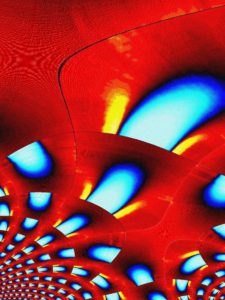
The interplay between disorder and superconductivity is a fundamental problem of condensed matter physics. On increasing disorder or magnetic field (B) a thin superconducting film can undergo a transition an insulating state. A body of experimental work indicates that the underlying mechanism relies on the localization of Cooper-pairs. Such a T=0 quantum phase transition, which involves Cooper pairs as charge carriers, provides a prototypical system to address the physics of strongly interacting, many-body system of electrons in low-dimension.
Our activites mainly focus on thin films of amorphous indium oxide and molybden-germanium, which exhibit a superconductor-to-insulator transition. On the superconducting side of the transition, we performed a pioneering STM spectroscopy study of the superconducting gap, which demonstrated that Cooper-pairs are not suppressed at the critical disorder, but remain in the insulator in the form of localized Cooper-pairs. We also unveiled a strong pseudogap in the density-of-states above Tc, which signals the preformation of Cooper-pairs.
Beyond the critical disorder or critical magnetic field, the insulator that terminates superconductivity is attracting considerable interest due to the mounting evidences that the charge carriers in it are electron pairs. In collaboration with Dan Shahar from the Weizmann Institute of Science, we focus our effort on magneto-transport studies on thin films. Our joint experiments on the Cooper-pair insulator showed that the electron-phonon coupling is significantly weakened in this insulator, and that a finite temperature transition to a zero-conductivity state occurs, pointing to a possible many-body localization scenario for Cooper-pairs.
Publications:
- B. Sacépé, et al. Quantum breakdown of superconductivity in low-dimensional materials, Nature Physics 16, 734 (2020)
- I. Tamir, et al. Extreme Sensitivity of the Superconducting State in Thin Films, Science Advances 5:eaau3826 (2019)
- T. Dubouchet, et al. Collective energy gap of preformed Cooper-pairs in disordered superconductors, Nature Physics 15, 233 (2019)
- B. Sacépé, et al. Low-temperature anomaly in disordered superconductors near Bc2 as a vortex-glass property, Nature Physics 15, 48-53 (2019)
- H. Kim, et al. Pair-breaking quantum phase transition in superconducting nanowires, Nature Physics 14, 912 (2018)
- A. Doron, et al. Instability of Insulators near Quantum Phase Transitions, Phys. Rev. Lett. 119, 247001 (2017)
- M. Ovadia, et al. Evidence for a Finite Temperature Transition, Scientific Reports, 5:16503 (2015)
- B. Sacépé, et al. High field termination of a Cooper-pair insulator, Phys. Rev. B 91, 220508(R) (2015)
- Z. Han, et al. Collapse of superconductivity in a hybrid tin-graphene Josephson junction array, Nature Physics 10, 380 (2014)
- M. Ovadia, et al. Duality symmetry and its breakdown in the vicinity of the superconductor-insulator transition, Nature Physics 9, 415 (2013)
- B. Sacépé, et al. Localization of preformed Cooper-pairs in disordered superconductors, Nature Physics 7, 239 (2011)
- B. Sacépé, et al. Pseudogap in a thin film of a conventional superconductor, Nature Communications 1:140 (2010)
- M. Ovadia, et al. Electron-Phonon Decoupling in Disordered Insulators, Phys. Rev. Lett. 102, 176802 (2009)
- B. Sacépé, et al. Disorder-Induced Inhomogeneities of the Superconducting State Close to the Superconductor-Insulator Transition, Phys. Rev. Lett. 101, 157006 (2008)
Collaborations: Mikhail Feigel’man (Landau Institute for Theoretical Physics), Lev Ioffe (Google), Marc Scheffler (Stuttgart Univ.), Karen Michaeli (Weizmann Ins.), Andrey Rogachev (Univ. of Utah), Dan Shahar (Weizmann Ins.).
